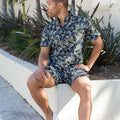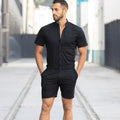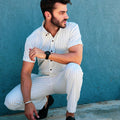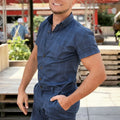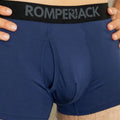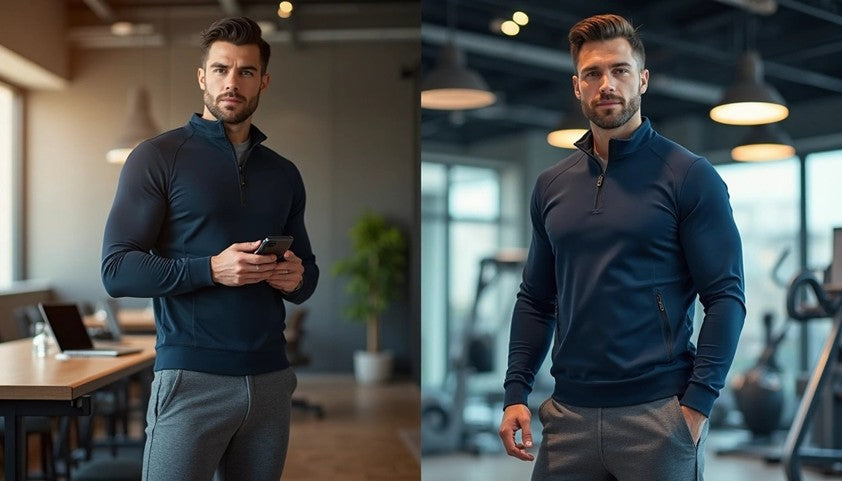The athleisure fashion market has grown into a massive $155.2 billion global industry with strong momentum. Men now wear this style as their power dress code in professional settings of all types. Market experts project this sector will grow to $257.1 billion by 2026, maybe even reaching $547 billion by 2024.
Athleisure combines athletic functionality with everyday style to create versatile clothing that works in multiple settings. The pandemic pushed athleisure orders up by 84%, which proves what we already knew - people now prioritize comfort over formality. The U.S. sports apparel market reached $105.1 billion in 2020, showing how men's athleisure style dominates our closets.
Major brands from Nike to Primark have entered this $44 billion U.S. market. Companies like Gymshark saw their sales increase by over 150% during peak lockdowns. Athleisure represents more than just a trend - it marks a fundamental change in our approach to fashion, comfort, and professional appearance. This piece will explore why athleisure has become men's new power dress code and how you can add it to your style.
What is Athleisure and Why It Matters Today
Athleisure fashion combines comfort and style in a unique way. This fashion philosophy goes beyond the usual lines between workout clothes and everyday wear. The word itself blends "athletic" and "leisure," which shows exactly what it means. These clothes let you switch naturally from exercise to social activities while looking good and staying comfortable.
The meaning of athleisure fashion
Athleisure is not just about clothes—it shows how our approach to dressing has changed. These clothes use technical fabrics and body-friendly fits that help you move freely while keeping a clean, simple look. What sets athleisure apart is how it takes sportswear out of the gym and raises it to new heights with sophisticated design.
Comfort, versatility, and style are the foundations of athleisure. The clothes use synthetic materials like polyester, nylon, and spandex that breathe well, stretch, and handle sweat. The style usually sticks to solid colors and clean lines, which helps create looks that work in many settings. You'll often see these athleisure pieces:
· Yoga pants and high-waist leggings
· Joggers and stretch chinos
· Technical t-shirts and hoodies
· Sleek, minimalist sneakers
How it is different from traditional sportswear
People often mix up athleisure and activewear, but they serve different purposes. Activewear focuses on performance and function for exercise, while athleisure balances fashion with lifestyle needs. As one expert says, "athleisure is a fashion, activewear is a practicality".
The main difference lies in purpose and design thinking. Activewear exists to make you perform better with special fabrics and construction. Athleisure takes these technical features and combines them with fashionable elements. These clothes have looser fits, trendy colors, and stylish details that make them more than just gym wear.
Why men are embracing athleisure now
Men's athleisure has grown remarkably, with orders up 20% compared to pre-pandemic levels. Several social changes explain this growth. Remote work has changed how we dress for work, making comfortable yet professional clothes essential. New synthetic fabrics now offer great comfort without looking messy.
The COVID-19 pandemic sped up this trend. Men found they could look professional on video calls while staying comfortable. The wellness movement has also pushed men to buy fitness clothes that work well for different activities.
Athleisure fits perfectly with modern men's busy lives. A good pair of joggers with a technical shirt works for morning workouts and afternoon meetings. This flexibility matches what people want today—practical clothes that look good and work in any situation.
From Gym to Boardroom: The Evolution of Men’s Athleisure Style
The experience of men's athletic clothing has come a long way from basic gym wear to becoming a fashion statement. This rise spans over a century of cultural progress. A look back at this transformation shows how athleisure has altered the map of men's fashion and workplace norms.
Early sportswear and its limited use
Men's athletic wear started with simple practical purposes. Sports attire in the early 20th century stayed within athletic venues—tennis whites belonged on courts, track suits in gymnasiums, and swimming trunks at pools. This strict separation existed because sports clothing was built just for performance, not everyday wear.
Men's early sportswear had scratchy wool materials, baggy cuts, and designs that put durability before comfort. These clothes didn't have the technical fabrics we take for granted today. Cotton, wool, and simple synthetic blends were common, with minimal stretch and poor moisture control. This created clear lines—athletic wear belonged in sports spaces, business attire in professional settings.
Social norms and practical concerns kept these worlds separate. People would think a man wearing gym clothes in public was dressed inappropriately. Society managed to keep strict dress codes that drew clear lines between recreational activities and professional spaces.
The fitness boom of the 80s and 90s
The 1980s fitness revolution brought the first big change in athletic wear's cultural standing. Aerobics, jogging, and bodybuilding became mainstream, bringing their unique fashions with them. Athletic wear stepped beyond gym walls through fitness celebrities, workout videos, and popular media.
This era brought better synthetic fabrics, improved manufacturing, and bold designs. Nike and Adidas grew beyond sports performance to become lifestyle brands. Their logos and designs started carrying social weight.
Sports-specific clothing stayed mostly separate from everyday wear, though track suits sometimes appeared in casual settings. Notwithstanding that, this period laid the groundwork for athleisure by making athletic looks normal in popular culture.
Streetwear and luxury fashion merge
Today's athleisure really started when hip-hop culture adopted sportswear in the 1990s and early 2000s. Basketball shoes, tracksuits, and athletic jerseys became fashion pieces beyond their sports roots. This cultural shift gave athletic wear new meaning outside performance.
Luxury fashion started borrowing from sportswear at the same time. Designer sneakers hit the runways, technical fabrics joined high-fashion collections, and athletic shapes influenced couture. This mix of high fashion and athletic wear lifted sportswear's status significantly.
Premium athletic brands further mixed these styles. Companies like Lululemon created athletic wear refined enough for non-workout settings. Their soaring win showed people just needed versatile clothes that mixed performance with style.
The rise of remote work and casual dress codes
The final push for men's athleisure came from changing workplace rules. Formal dress codes were already relaxing across industries before the pandemic. Tech companies led the way with casual workplace clothes, making jeans and sneakers okay in once-formal spaces.
Remote work sped up this trend. Video meetings only showed upper bodies, so comfort became crucial for pants and shorts. Men found they could look professional while wearing comfortable, stretchy bottoms.
This change matched technical breakthroughs that made athletic-inspired clothing more sophisticated. Performance fabrics got better, offering moisture-wicking, four-way stretch, and wrinkle resistance while looking polished. Athleisure designers added tailored touches—creating joggers that looked like chinos, technical shirts similar to oxfords, and refined sneakers fit for business.
Now, athleisure offers the perfect answer for modern men moving between home offices, gyms, social spots, and workplaces. These clothes bring comfort without losing style, versatility without sacrificing function. This progress—from basic sportswear to sophisticated athleisure—mirrors bigger cultural changes in how we see work, leisure, and the lines between them.
The Role of Celebrities and Social Media in Normalizing Athleisure
Celebrity endorsements turned athleisure from gym wear into acceptable everyday fashion. The push toward comfort-focused clothing gained massive momentum through strategic collaborations and celebrity brand launches.
Influencer marketing and Instagram aesthetics
Social media, especially Instagram, changed athleisure from a sporty trend into a complete lifestyle movement. The trend hit mainstream status in 2016 through stars like Beyoncé and Rihanna, who launched athleisure collections with Puma and Topshop. These celebrities used Instagram as their virtual runway and turned casual athletic wear into must-have style statements.
Instagram's visual platform gave us countless "selfie-ready" moments of celebrities who mixed leggings with regular clothes. They created versatile outfits that inspired millions of followers to dress more casually. This visual storytelling made athleisure both fashionable and practical. Brands now work with social media influencers to learn about customer priorities and design activewear.
Celebrity-led brands like Fabletics and Ivy Park
Celebrity athleisure brands became powerful marketing tools that made the trend more legitimate. Kate Hudson's Fabletics, which she started with co-founders Don Ressler and Adam Goldenberg, stood out by offering affordable prices instead of premium ones. Hudson wanted to make athleisure available to everyone, saying she wanted "to create something that was more about a lifestyle than an actual fitness brand".
Beyoncé's Ivy Park (launched in 2016, later partnered with Adidas in 2019) shows how celebrity-backed athleisure can disrupt culture. Her limited-release gender-inclusive collection in January 2023 sold out instantly. Ivy Park has over 1 million Instagram followers and ranks among the most-followed athleisure brands, along with other celebrity-backed labels like Fabletics.
How public figures redefined power dressing
Celebrities changed how we think about "power dressing." Comfort didn't just enter our wardrobes after the pandemic—it became essential to new style rules. A-list figures showed that confidence looks different now: "a structured blazer thrown over yoga tights" carries as much authority as traditional business attire.
This new definition crosses gender lines, too. To name just one example, when Kareena Kapoor Khan and Olympic medalist PV Sindhu worked with Puma India, they presented athleisure as a statement of "strength, confidence, and modern femininity". Their campaign showed performance wear not as casual clothing but as a way to express inner validation and self-worth.
The new approach to power dressing reflects bigger changes in values: "today's woman doesn't dress for the male gaze, the office dress code, or even the trend cycle—she dresses for herself". Men's athleisure follows the same idea, where comfort and personal style have replaced strict formality as signs of confidence and success.
Function Meets Fashion: Why Athleisure Works for Modern Men
Men's athleisure fashion shines because it perfectly combines function with style. This mix has reshaped how modern men build their wardrobes, setting a new standard that values both performance and looks.
Performance fabrics and comfort
Modern athleisure pieces use advanced technical fabrics that offer unique comfort. These performance materials blend stretchy, athletic qualities with breathable, lightweight construction. The fabrics include moisture-wicking technology that pulls sweat away from your body and keeps you dry, whatever you're doing. The materials often have anti-microbial properties that fight odor buildup, so you can wear them longer between washes.
These performance textiles last longer and flex better than traditional natural fabrics. Most men now look for clothes with a bit of stretch—pieces made with spandex, nylon, or polyester blends that move naturally with their body.
Versatility across settings
Beyond comfort, men's athleisure stands out because you can wear it anywhere. Today's pieces combine smoothly with workouts, social events, and some work environments. You won't need to change clothes multiple times during your busy day.
Athleisure has become the go-to choice for men who juggle active lifestyles with work. Technical joggers, moisture-wicking tees, and structured hoodies let you switch between work, gym, and social life while looking good.
Minimalist design and sleek silhouettes
The beauty of athleisure comes from its clean, simple design approach. Unlike regular sportswear, athleisure has tailored fits and sleek shapes. The main difference shows in the fit—athleisure runs on clean lines and smooth proportions that hit the sweet spot between casual and polished.
The appeal of effortless style
Athleisure means more than just comfortable clothes—it's about making style look easy. This easy-going look takes some thought to get right. Men love it because they look put-together without trying too hard.
Men find athleisure especially appealing because it makes choosing what to wear much simpler. Combined with its performance benefits, it's a wardrobe solution that fits their lifestyle while keeping them looking sharp.
Sustainability, Inclusivity, and the Future of Men’s Athleisure Fashion
Men's athleisure fashion is changing through three main forces: sustainability, inclusivity, and state-of-the-art technology.
Eco-friendly materials and ethical production
Men's athleisure brands are moving towards environmental responsibility. Modern consumers consider sustainability a priority in their purchasing decisions. Companies now use recycled materials—from plastic bottles to fishing nets—in their performance fabrics. Several brands experiment with organic cotton, bamboo, and hemp blends that reduce environmental impact while maintaining functionality.
Size inclusivity and body positivity
Men's athleisure welcomes broader size ranges and more diverse body types in products and marketing. Similar to women's fashion movements, brands now acknowledge that athletic wear should fit bodies of all shapes and sizes. This change shows that fitness and style belong to everyone, regardless of body type.
Tech-infused fabrics and smart wearables
Technological integration marks athleisure's next frontier. Smart fabrics with temperature regulation, improved durability, and antimicrobial properties have become standard features. Progressive brands incorporate sensors directly into garments to track movement, posture, and biometric data.
Predictions for the next wave of athleisure trends
Industry experts predict men's athleisure will merge distinct categories—formal meets casual, indoor meets outdoor, technology meets tradition. The momentum suggests we'll see sophisticated designs that balance aesthetics and performance while addressing ethical concerns. Brands that remain proactive in sustainability, inclusivity, and state-of-the-art technology will lead the market.
Conclusion
Athleisure fashion has altered the map of modern men's wardrobe choices. This style category has grown from simple gym wear into sophisticated attire that fits both boardrooms and casual settings. Men now choose comfort without compromising style. Performance fabrics provide exceptional functionality while keeping a refined look.
The market numbers paint a clear picture. A $155.2 billion industry keeps growing fast and could reach $550 billion in the coming years. These figures show more than just a fashion trend - they reveal a fundamental change in how we think about professional appearance and comfort.
Social media and celebrity influence have turned athleisure from workout-specific clothing into everyday power dressing. What people once called casual has become a legitimate style statement that shows confidence and adaptability.
Athleisure meets the needs of modern men who balance multiple responsibilities. These versatile pieces are a great way to get more from today's busy lifestyles. They help you move naturally between morning workouts, video conferences, and evening social events.
The men's athleisure future looks bright. Sustainability initiatives, size inclusivity, and technological advances will challenge what performance clothing can do. Athleisure shows our changing values - comfort doesn't mean giving up style anymore. Function and fashion now work together perfectly.
This new power dress code means more than just comfortable clothes. It represents freedom from old rules while solving problems in our active lives. As someone who has seen this change firsthand, athleisure isn't just changing our clothes - it's changing our lives.
